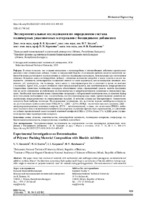| dc.contributor.author | Кузьмич, В. В. | |
| dc.contributor.author | Козлов, Н. Г. | |
| dc.contributor.author | Карпунин, И. И. | |
| dc.contributor.author | Балабанова, О. В. | |
| dc.coverage.spatial | Минск | ru |
| dc.date.accessioned | 2019-10-21T12:57:32Z | |
| dc.date.available | 2019-10-21T12:57:32Z | |
| dc.date.issued | 2019 | |
| dc.identifier.citation | Экспериментальные исследования по определению состава полимерных упаковочных материалов с биоцидными добавками = Experimental Investigations on Determination of Polymer Packing Material Composition with Biocide Additives / В. В. Кузьмич [и др.] // Наука и техника. – 2019. – № 5. – С. 409-415. | ru |
| dc.identifier.uri | https://rep.bntu.by/handle/data/58121 | |
| dc.description.abstract | В статье показано, что создание материалов с антимикробным и антигрибковым действием предполагает введение в них специальных добавок. Одним из направлений борьбы с плесневыми грибами является включение добавок биоцидов растительного происхождения в структуру полимерных материалов, используемых для изготовления упаковки. Основная задача антимикробных добавок – снижение количества микробов в массе изделия и на его поверхности. Активность антимикробных соединений зависит от таких параметров, как концентрация активного компонента, pH, температура, тип полимера, метод ввода (с пластификатором или в расплаве) и время их контакта с полимером. Кроме того, следует учитывать такой немаловажный фактор, как чувствительность микроорганизмов. Современные пленочные полимерные материалы обеспечивают лишь определенный уровень защиты продукции. Они не могут направленно воздействовать на биохимические и микробиологические изменения в упакованном продукте. Необходимо производить новые упаковочные материалы с избирательной проницаемостью, создающие барьер на пути излишне интенсивного газо- и влагообмена, поступления микрофлоры извне, препятствующие развитию нежелательных микроорганизмов на упаковываемых изделиях. В качестве основы для бактерицидного упаковочного материала были выбраны полимеры. Исследованиями установлено, что достаточно хорошо ингибировала (тормозила) рост плесневых грибов композиция ПЭВД 98 % + ДЖК + ДЭТА (ПЭВД – полиэтилен высокого давления; ДЖК – диспропорционированная живичная канифоль; ДЭТА – диэтилентриамин), а также, что композиция ПЭВД с добавками таллового пека и полиэтиленполиамина показали резкое ухудшение прочностных характеристик, а с увеличением добавки предполагаемой смеси сосновой живичной канифоли (СЖК) с ДЭТА (более 2 %) и ДЖК резко ухудшаются прочностные характеристики материала. | ru |
| dc.language.iso | ru | ru |
| dc.publisher | БНТУ | ru |
| dc.title | Экспериментальные исследования по определению состава полимерных упаковочных материалов с биоцидными добавками | ru |
| dc.title.alternative | Experimental Investigations on Determination of Polymer Packing Material Composition with Biocide Additives | ru |
| dc.type | Article | ru |
| dc.identifier.doi | 10.21122/2227-1031-2019-18-5-409-415 | |
| local.description.annotation | The paper shows that creation of materials with antibacterial and antifungal action presupposes an introduction of additives in them. One of the directions concerning fight against mold fungi is an inclusion of biocide additives having vegetable origin in structure of polymer materials used for manufacturing packing products. The main mission of antimicrobial additives is reduction of microbe amount in product mass and on its surface. Activity of antimicrobial compounds depends on the following parameters: concentration of active component, pH, temperature, polymer type, introduction method (with plasticizer or in melting state) and time period of their contact with polymer. In addition it is necessary to take into account such not unimportant factor as sensitivity of microorganisms. Modern film polymer materials ensure only a certain level of product protection. They can not targetedly affect biochemical and microbiological changes in a packing product. It is necessary to develop new packing materials with selective permeability that create a barrier on the way of extremely intensive gas- and moisture exchange, outside microflora flow, and prevent an evolution of undesired microorganisms on packing products. Polymers have been selected as a basis for a bactericide packing material. Investigations have shown that composition including PEHP 98% (polyethylene of high pressure) + DGR (disproportionate gum rosin) + DETA (diethylenetriamine) has inhibited (hindered) sufficiently in a good way growth of mold fungi and PEHP composition with additives of tallow pitch and polyethylenepolyamine has demonstrated a rapid deterioration of strength characteristics and an increase in additive of the supposed mixture including pine oleoresin (POR) with DETA and DGR (with DETA more than 2%) hinders rapidly strength material characteristics. | ru |

